高中英语必修一教案教学文稿
人教版高中英语必修1教案5篇
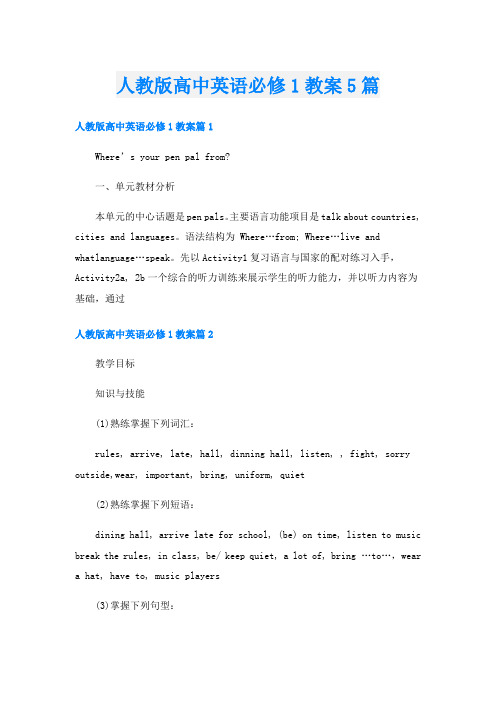
人教版高中英语必修1教案5篇人教版高中英语必修1教案篇1Where’s your pen pal from?一、单元教材分析本单元的中心话题是pen pals。
主要语言功能项目是talk about countries, cities and languages。
语法结构为 Where…from; Where…live and whatlanguage…speak。
先以Activity1复习语言与国家的配对练习入手,Activity2a, 2b一个综合的听力训练来展示学生的听力能力,并以听力内容为基础,通过人教版高中英语必修1教案篇2教学目标知识与技能(1)熟练掌握下列词汇:rules, arrive, late, hall, dinning hall, listen, , fight, sorry outside,wear, important, bring, uniform, quiet(2)熟练掌握下列短语:dining hall, arrive late for school, (be) on time, listen to music break the rules, in class, be/ keep quiet, a lot of, bring …to…,weara hat, have to, music players(3)掌握下列句型:1. Dont eat in class.2. You must be on time.3. Eat in the dining hall.4. 正确使用情态动词can, can’t——Can we wear a hat in school?——Yes, we can./No, we can’t.5. 能正确使用have to 和 must 谈论规章制度We must be on time/ We also have to be quiet in the library. 教学重难点重点:1) 肯定祈使句是省略掉主语的原形动词开头;2) 否定祈使句则是在肯定祈使句前加上“don’t”。
高一英语教案优秀教案5篇

【导语】⾼中阶段学习难度、强度、容量加⼤,学习负担及压⼒明显加重,不能再依赖初中时期⽼师“填鸭式”的授课,“看管式”的⾃习,“命令式”的作业,要逐步培养⾃⼰主动获取知识、巩固知识的能⼒,制定学习计划,养成⾃主学习的好习惯。
今天⾼⼀频道为正在拼搏的你整理了《⾼⼀英语教案优秀教案5篇》,希望以下内容可以帮助到您!1.⾼⼀英语教案优秀教案 ⼀、教材分析: 学⽣在度过⼀个假期后,英语知识较⽣疏,教师应当复习好以前单词,为学习新知打下基础。
Let’s talk A部分很好地体现了这⼀点。
Good morning We have a……复习民第⼀册中内容。
“I’m from America”这⼀句为B Let’s taik“Where are you from?做了铺垫,教师应充分注意这⼀点 boy、girl 、teacher student 、meet等单词⼜是第⼀次出现,也需要我们特别关注。
⼆、教学⽬标: 1、能够得简单地表达⾃⼰⼼情,如:nice to meet you welcome back to school 2、能够听懂并回答 Where are you from? I’m from 3、认识、会说字母A——E 4、掌握A、B Ler’s talk中单词。
5、理解A、B Ler’s talk中内容。
三、教学重、难点: 能够听懂并回答 Where are you from? 掌握A、B Ler’s talk中单词。
理解A、B Ler’s talk中内容。
四、课时安排 第⼀课时 A lLet’s talk Let’s learn B Let’s sing 第⼆课时 A Let’s practise Let’s play Let’s chant 第三课时 B lLet’s talk Let’s learn 第四课时 BLet’ssay Let’spractise 第五课时 B Let’s Let’s 第六课时 C story time2.⾼⼀英语教案优秀教案 教学⽬标 To help students learn to express attitudes, agreement & disagreement and certainty To help students learn to read the text and learn to write diaries in English To help students better understand “friendship” To help students learn to understand and use some important words and expressions To help students identify examples of Direct Speech & Indirect Speech (I): statements and questions in the text 教学重难点 Words upset, ignore, calm, concern, settle, suffer, recover, pack Expressions add up, calm down, have got to, be concerned about, go through, set down, a series of, on purpose, in order to, at dusk, face to facer, no longer/ not …any longer, suffer from, get/ be tired of, pack (sth.) up, get along with, fall in love, join in Patterns “I don’t want to set down a series of facts in a diary as most people do,” said Anne. →Anne said that she didn’t want to set down a series of facts in a diary as most people do. I stayed awake on purpose until half past eleven… …it was the first time in a year and a half that I’d seen the night face to face… 教学⼯具 ppt 教学过程 Hello, everyone. I’m so glad to be your teacher of English. I’d like to make friends with you, to build up a close friendship with you. Today we shall take Unit 1. The topic of this unit is Friendship. What do you think friendship is? 1. Warming up ⑴ Warming up by defining friendship Hello, everyone. I’m so glad to be your teacher of English. I’d like to make friends with you, to build up a close friendship with you. Today we shall take Unit 1. The topic of this unit is Friendship. What do you think friendship is? Yeah, there are many explanations about friendship. However, friendship is a relationship that can’t be restricted(限制)by definition(定义). It can only be experienced. True friendship can exist between any two souls, be it between people or animals. It can happen at any moment, to anyone. Even to lifeless things, like a diary, a ball, a friendship can happen. Then what is your opinion about friendship? Do you think that friendship is important to our life? Why? ⑵Warming up by learning to solve problems Nice to meet you, class. We shall be friends from now on. For everybody needs friends. But being a good friend can sometimes be hard work. Learning how to solve problems in a friendship can make you a better friend and a happier person. Discuss the situation below and try to solve the problems wisely. Common problems among teenagers Solution Some of the common problems include forgetting friends’ birthday, not keeping promises, letting out friends’ secrets and so on. Maybe we can have a heart-to-heart talk with our friends to ask for forgiveness. Situation 1: Friends get angry with each other when they try to talk about something difficult. Try to understand your friend/ Try to talk about the problem in a different way. Situation 2: Friends don’t know how to apologize Start by telling each other that you are sorry. A simple apology is often enough and is a good starting point. Situation 3: Some friends don’t know how to keep secrets. Keep your secrets to yourself Tips on being a good friend Treat your friends the way you want to be treated. Keep secrets that are told to you. Pay attention when your friend is talking. Keep your promises. Share things with your friend. Tell your friend the truth. Stick up for your friend. ⑶Warming up by doing a survey Good morning, class. I am your teacher of English. Glad to be here with you. Today we shall take Unit 1 Friendship. To be frankly, I’d like very much to keep a close friendship with you, my dear students, in the following years. How about you then? Ok, thanks. I do hope to be your good teacher as well as your helpful friend (良师益友). Now please do the survey on page one. Add up your score according to the scoring sheet on page 8. You don’t have to tell your results. You can just keep it a secret.3.⾼⼀英语教案优秀教案 教学⽬标 Knowledge and ability: To help the Ss know about the history of the Amber room and develop their reading skills. Process and method: Ss acquire knowledge and improve ability through discussion and competition. Emotion, attitude and values: to arouse Ss's awareness of protecting the cultural relics. Understand cultural relics belong to the whole world and the human beings. 教学重难点 important point: Understand the content of the whole passage and master the different reading skills,such as ,skimming, scanning and so on. difficult point : how to solve the questions and find the useful information using the reading skills. 教学⼯具 课件 教学过程 Lead in 1. show some pictures . 2. show the pictures and a short video of amber room. purpose: motive Ss's interest. Hi, everyone. Let’s look at the screen. I’ll present you some pictures. They are all about cultural relics. Some of them are cultural sites. Some of them are natural sites. Only an international professional organization from UN has the right to decide on and name them. Presentation Look at the photos here. What do you know about the substance of “amber”? What do know about the cultural relics “the Amber Room”? discussion: Now, boys and girls, I met a “moral dilemma”. That means I must make a choice between the interests of the family and the interests of the society. Things are like this: My old granny happened to find an ancient vase under a tree in the earth of our garden. It’s so beautiful and special. Now, my family fell into a moral dilemma. Can you help us to make a decision? A: What should we do? B: Can we keep it for ourselves or report it to the government? C: Have you come across such a situation — to make a difficult choice? listen and answer the questions: Play tape. Ss get the main idea of the passage. Reading pre-reading: 1. Have you ever seen a piece of amber? What do you know about it? 2. look at the title and the picture. predict what it is about. Then skim it quickly and see if you were right. Reading: 1st time: read by yourself as quickly as you can. join the correct parts of the sentences together. 2nd time:choices and T/F compete between boys and girls. 3rd time: answer some question. Ask ss to think over and discuss. purpose: understand the text better and arouse Ss's awareness of competition. Grasp the main information. Discussion and report Think over of what we discuss in the part of warming up: I find myself falling into the dilemma. you discuss together ,and write down the outline of a report. work in group Consolidation fill in the blanks (summary). Homework make a report . use the useful information in the passage.4.⾼⼀英语教案优秀教案 Period 7-8 Grammar Grammar ⼀、动名词做主语的⽤法 动名词做主语往往表⽰经常性、习惯性的动作,在⼝语中也可以表⽰具体的动作。
高一英语必修一教案(优秀5篇)
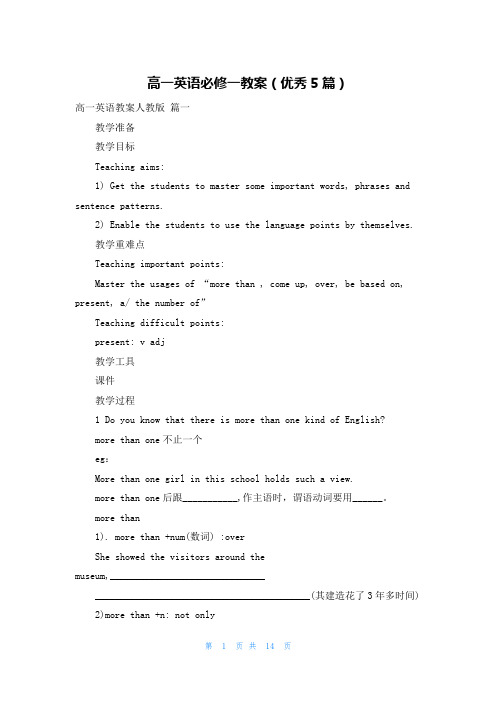
高一英语必修一教案(优秀5篇)高一英语教案人教版篇一教学准备教学目标Teaching aims:1) Get the students to master some important words, phrases and sentence patterns.2) Enable the students to use the language points by themselves.教学重难点Teaching important points:Master the usages of “more than , come up, over, be based on, present, a/ the number of”Teaching difficult points:present: v adj教学工具课件教学过程1 Do you know that there is more than one kind of English?more than one不止一个eg:More than one girl in this school holds such a view.more than one后跟___________,作主语时,谓语动词要用______。
more than1). more than +num(数词) :overShe showed the visitors around themuseum,__________________________________________________________________________(其建造花了3年多时间) 2)more than +n: not onlyMusic is more than just a sound--- it’s a way of thin king.3) more than +adj/v : very听到这个消息我很高兴。
高一英语必修一unit1教案(优秀3篇)
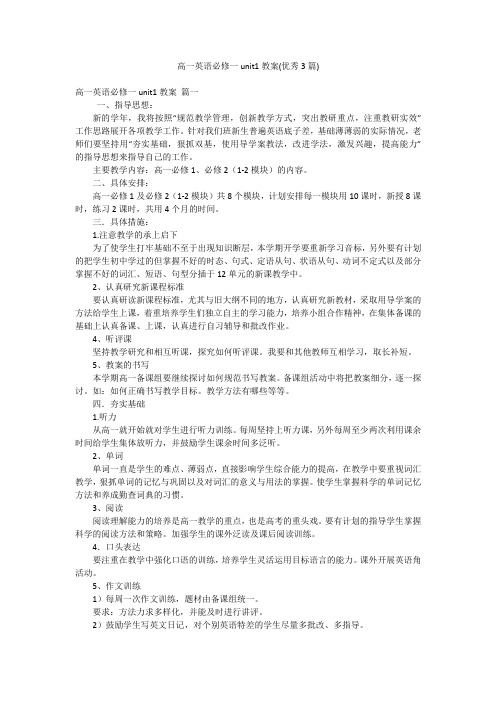
高一英语必修一unit1教案(优秀3篇)高一英语必修一unit1教案篇一一、指导思想:新的学年,我将按照“规范教学管理,创新教学方式,突出教研重点,注重教研实效”工作思路展开各项教学工作。
针对我们班新生普遍英语底子差,基础薄薄弱的实际情况,老师们要坚持用“夯实基础,狠抓双基,使用导学案教法,改进学法,激发兴趣,提高能力”的指导思想来指导自己的工作。
主要教学内容:高一必修1、必修2(1-2模块)的内容。
二、具体安排:高一必修1及必修2(1-2模块)共8个模块,计划安排每一模块用10课时,新授8课时,练习2课时,共用4个月的时间。
三.具体措施:1.注意教学的承上启下为了使学生打牢基础不至于出现知识断层,本学期开学要重新学习音标,另外要有计划的把学生初中学过的但掌握不好的时态、句式、定语从句、状语从句、动词不定式以及部分掌握不好的词汇、短语、句型分插于12单元的新课教学中。
2、认真研究新课程标准要认真研读新课程标准,尤其与旧大纲不同的地方,认真研究新教材,采取用导学案的方法给学生上课,着重培养学生们独立自主的学习能力,培养小组合作精神,在集体备课的基础上认真备课、上课,认真进行自习辅导和批改作业。
4、听评课坚持教学研究和相互听课,探究如何听评课。
我要和其他教师互相学习,取长补短。
5、教案的书写本学期高一备课组要继续探讨如何规范书写教案。
备课组活动中将把教案细分,逐一探讨。
如:如何正确书写教学目标。
教学方法有哪些等等。
四.夯实基础1.听力从高一就开始就对学生进行听力训练。
每周坚持上听力课,另外每周至少两次利用课余时间给学生集体放听力,并鼓励学生课余时间多泛听。
2、单词单词一直是学生的难点、薄弱点,直接影响学生综合能力的提高,在教学中要重视词汇教学,狠抓单词的记忆与巩固以及对词汇的意义与用法的掌握。
使学生掌握科学的单词记忆方法和养成勤查词典的习惯。
3、阅读阅读理解能力的培养是高一教学的重点,也是高考的重头戏。
高一英语必修一unit1教案
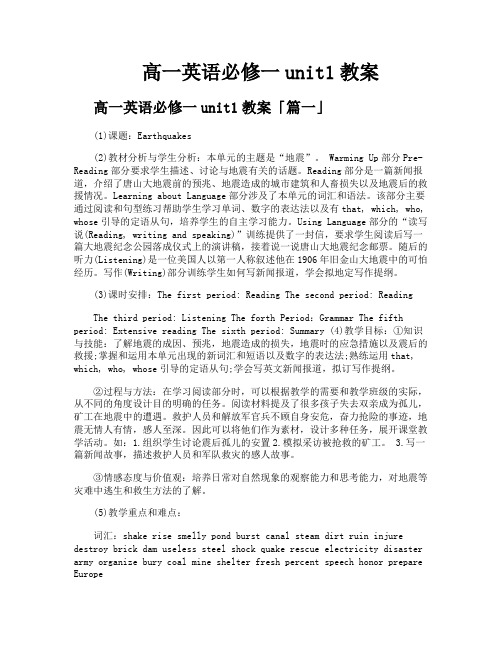
高一英语必修一unit1教案高一英语必修一unit1教案「篇一」(1)课题:Earthquakes(2)教材分析与学生分析:本单元的主题是“地震”。
Warming Up部分Pre-Reading部分要求学生描述、讨论与地震有关的话题。
Reading部分是一篇新闻报道,介绍了唐山大地震前的预兆、地震造成的城市建筑和人畜损失以及地震后的救援情况。
Learning about Language部分涉及了本单元的词汇和语法。
该部分主要通过阅读和句型练习帮助学生学习单词、数字的表达法以及有that, which, who, whose引导的定语从句,培养学生的自主学习能力。
Using Language部分的“读写说(Reading, writing and speaking)”训练提供了一封信,要求学生阅读后写一篇大地震纪念公园落成仪式上的演讲稿,接着说一说唐山大地震纪念邮票。
随后的听力(Listening)是一位美国人以第一人称叙述他在1906年旧金山大地震中的可怕经历。
写作(Writing)部分训练学生如何写新闻报道,学会拟地定写作提纲。
(3)课时安排:The first period: Reading The second period: ReadingThe third period: Listening The forth Period:Grammar The fifth period: Extensive reading The sixth period: Summary (4)教学目标:①知识与技能:了解地震的成因、预兆,地震造成的损失,地震时的应急措施以及震后的救援;掌握和运用本单元出现的新词汇和短语以及数字的表达法;熟练运用that, which, who, whose引导的定语从句;学会写英文新闻报道,拟订写作提纲。
②过程与方法:在学习阅读部分时,可以根据教学的需要和教学班级的实际,从不同的角度设计目的明确的任务。
高中英语必修1说课稿
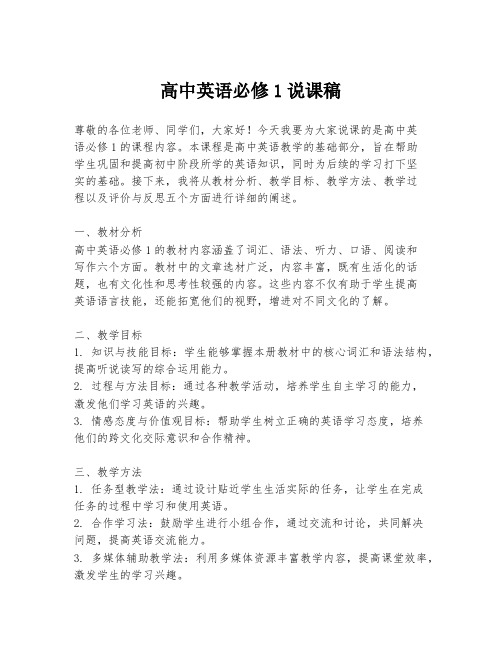
高中英语必修1说课稿尊敬的各位老师、同学们,大家好!今天我要为大家说课的是高中英语必修1的课程内容。
本课程是高中英语教学的基础部分,旨在帮助学生巩固和提高初中阶段所学的英语知识,同时为后续的学习打下坚实的基础。
接下来,我将从教材分析、教学目标、教学方法、教学过程以及评价与反思五个方面进行详细的阐述。
一、教材分析高中英语必修1的教材内容涵盖了词汇、语法、听力、口语、阅读和写作六个方面。
教材中的文章选材广泛,内容丰富,既有生活化的话题,也有文化性和思考性较强的内容。
这些内容不仅有助于学生提高英语语言技能,还能拓宽他们的视野,增进对不同文化的了解。
二、教学目标1. 知识与技能目标:学生能够掌握本册教材中的核心词汇和语法结构,提高听说读写的综合运用能力。
2. 过程与方法目标:通过各种教学活动,培养学生自主学习的能力,激发他们学习英语的兴趣。
3. 情感态度与价值观目标:帮助学生树立正确的英语学习态度,培养他们的跨文化交际意识和合作精神。
三、教学方法1. 任务型教学法:通过设计贴近学生生活实际的任务,让学生在完成任务的过程中学习和使用英语。
2. 合作学习法:鼓励学生进行小组合作,通过交流和讨论,共同解决问题,提高英语交流能力。
3. 多媒体辅助教学法:利用多媒体资源丰富教学内容,提高课堂效率,激发学生的学习兴趣。
四、教学过程1. 导入新课:通过图片、视频或情景模拟等方式,创设情境,激发学生的学习兴趣,为新知识的学习做好铺垫。
2. 呈现新知:清晰地讲解新词汇和语法点,利用例句和语境帮助学生理解和记忆。
3. 操练巩固:设计各种练习活动,如填空、连线、角色扮演等,让学生在实践中巩固新学的知识。
4. 产出应用:通过写作、演讲、辩论等形式,让学生将所学知识运用到实际中,提高语言运用能力。
5. 总结反馈:对学生的学习进行总结,给予及时的反馈和评价,帮助他们找出不足,明确努力方向。
五、评价与反思1. 形成性评价:通过课堂观察、小测验、作业等方式,了解学生的学习进度和掌握情况,及时调整教学策略。
新课标高中英语1必修全册教案

新课标高中英语1必修全册教案一、教学内容1. Unit 1 My First Day at Senior High详细内容:描述了学生在高中的第一天,通过对话和阅读了解校园生活。
2. Unit 2 My New Teachers详细内容:介绍了几位不同风格的老师,学习如何描述人物特点。
二、教学目标1. 掌握本单元的重点词汇和短语,并能灵活运用到实际情景中。
2. 提高学生的听说读写能力,尤其是描述人物和事件的能力。
3. 培养学生学会尊重和理解不同的教学风格,增强团队合作意识。
三、教学难点与重点1. 教学难点:描述人物特点的词汇和句型,以及如何运用到实际情景中。
2. 教学重点:听说读写技能的培养,尤其是口语表达能力的提高。
四、教具与学具准备1. 教具:多媒体设备、PPT、黑板、录音机、卡片等。
2. 学具:课本、练习本、字典、笔等。
五、教学过程1. 导入:通过展示一组学生在高中第一天的照片,引发学生讨论,导入新课。
2. 新课内容展示:讲解Unit 1 My First Day at Senior High 的重点词汇和句型,进行角色扮演活动。
3. 例题讲解:针对Unit 2 My New Teachers,讲解如何描述人物特点,给出示例。
4. 随堂练习:让学生运用所学知识,描述自己的老师,进行小组讨论。
5. 口语练习:模拟情景,让学生进行对话练习,提高口语表达能力。
六、板书设计1. Unit 1 My First Day at Senior High重点词汇:nervous, excited, confused, helpful, friendly等。
重点句型:I felt when; The teacher is and he/she等。
2. Unit 2 My New Teachers描述人物特点的词汇:strict, patient, humorous, knowledgeable等。
描述人物特点的句型:My teacher is; He/She always等。
英语必修一教案(合集4篇)
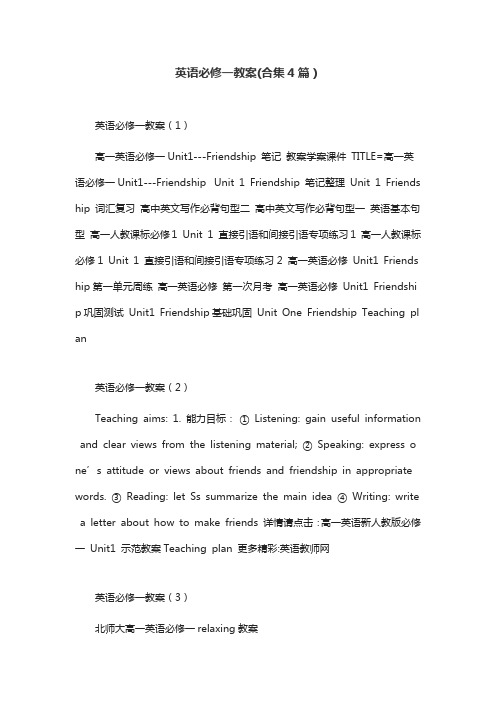
英语必修一教案(合集4篇)英语必修一教案(1)高一英语必修一Unit1---Friendship 笔记教案学案课件TITLE=高一英语必修一Unit1---Friendship Unit 1 Friendship 笔记整理Unit 1 Friends hip 词汇复习高中英文写作必背句型二高中英文写作必背句型一英语基本句型高一人教课标必修1 Unit 1 直接引语和间接引语专项练习1 高一人教课标必修1 Unit 1 直接引语和间接引语专项练习2 高一英语必修Unit1 Friends hip第一单元周练高一英语必修第一次月考高一英语必修Unit1 Friendshi p巩固测试Unit1 Friendship基础巩固Unit One Friendship Teaching pl an英语必修一教案(2)Teaching aims: 1. 能力目标:①Listening: gain useful information and clear views from the listening material; ②Speaking: express o ne’s attitude or views about friends and friendship in appropriate words. ③Reading: let Ss summarize the main idea ④Writing: write a letter about how to make friends 详情请点击:高一英语新人教版必修一Unit1 示范教案Teaching plan 更多精彩:英语教师网英语必修一教案(3)北师大高一英语必修一relaxing教案导语:编写教案要依据教学大纲和教科书。
从学生实际情况出发,精心设计。
以下是北师大高一英语必修一relaxing教案,供各位阅读和参考。
学习目标Students are to be able topredict what to hear.use the group of words related to stress.tell the ways to deal with the stress.教学流程学生背景升入高中后的第二节英语课。
高一英语必修一教案6篇
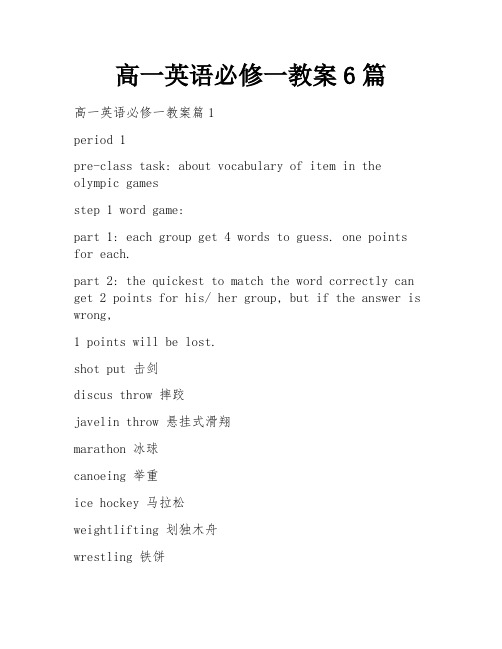
高一英语必修一教案6篇高一英语必修一教案篇1period 1pre-class task: about vocabulary of item in the olympic gamesstep 1 word game:part 1: each group get 4 words to guess. one points for each.part 2: the quickest to match the word correctly can get 2 points for his/ her group, but if the answer is wrong,1 points will be lost.shot put 击剑discus throw 摔跤javelin throw 悬挂式滑翔marathon 冰球canoeing 举重ice hockey 马拉松weightlifting 划独木舟wrestling 铁饼fencing 推铅球hang-gliding 标枪part 3: the quickest to guess the word correctly can get 2 points for his/ her group, but if the answer is wrong,1 points will be lost.rings, high bar, side hors(鞍马)e, vaulting horse(跳马), double bar, free exercisesstep 2 warming uptalk about when ,where, and anything you know about the olympics according to the pictures given.1. get ss to talk about picturesteacher can give one example2. let 2 ss share their understanding of the pictures and act it out for the classstep 3. speaking activity 1 ( warming up p17)page 49 now turn to page 49 and look at exx.1&21.read through the words and fill in the form2.work in pairs and make a simple dialogue using the information in the form by asking:do you know which sports are usually part of the winter olympics?which sports are played between team?in which sports are chinese athletes the best?3.pairs to act it outstep 4 speaking activity 2teacher help the ss to talk about their hobbies(about sports) by teaching them some expression.1. show some useful expressasking about giving answer, advice, and making decisiontaking about hobbies:1)which sport do you like best?what’s your favorite s port?what are your hobbies?which do you prefer, ..or..?are you interested in …?2)why do you like…?/what do you learn from…3)how do you bee good at them?4)can you tell me sth. about them? giving answer, and making decision:1)i prefer…(to)…/ i like …(best).2)i (don’t) like (because)…3)i (don’t) think…(it’s because)…4)i’m sure that…5)i’m not sure whether…6)there is no doubt…7)don’t you think that…?2. explain them if necessary.3. give some words of sports for ss to talk with their partner.4. act it outstep 6 homework1.find out the fact in warming up to the number given to you (it’ll be checked tomorrow)2.finish exx.1-4 on p11-123.《课程探究》exx 1&24.go over the new words.period 2step 1 number gamehave the ss to open the book on page 9, try to match the number to the events. the one who get the closest answer will get 1 point of the group1. show the number to the ss2. have the ss write down the answers by filling with the number in the table776 b. c. the ancient olympic games start in greece.393 a. d. the ancient olympic games stop1896 the modern olympic games start in greece.311&13 the numbers of petitors & countries took part in 18961932 china first joined in the games.1984 china first got gold medal by xuhaifeng.10.000&119 the numbers of petitors & countries joined in sydney olympicchina got the 2th place in athens.china will host the 29th summer olympics in beijing.3. check and give points to the group.step 2 pre-readingshowing the motto of the beijing 2008 olympic games bid (北京奥运申报口号) to the whole class.1. raise a question: “do you know more about the olympics history?”2. get the ss to read about an interview to get more.3. get the ss to make sure the relationship between pausanias and lilistep 3 reading prehensionread the olympic games1. make sure the information they have to get:the 29th olympics the old olympicsthe olympic gamesthe 27th olympics the modern olympics1st time: read the text quickly and find out the answers to the following qs:1). the old olympics: when / where / who/what to get2). the modern olympics: how often / how many sets / who3). the 27th olympics: when / where to live/ for the spirit of…4). the 29th olympic: when / where/ what to get2nd time: read the text carefully and answer the question on page 11,have the ss:. 1.read the passage again and find out the answers to the questions in ex 22.discuss the answers with your partner3.tell the whole class the answersstep 4 summing up1 individual work, take out a piece of paper to sum up the text2.pair work: “close the books, talk about the olympics with what you have learnt & your own knowledge.”3.act it outstep 5 homework1.《英语周报》知识点练习和短文改错2.finish ex.1 of a table on p113.p50 ex.2, p51 reading task4.go over notes on page 78-79.period 3 & 4step 1 homework checking & motivating1.check the homework2. talk the motto of modern olympic games:swifter/faster, higher, strongerstep 2 language points1. ss give the phrases and expressions according to the chinese t gives2. ss raise qs on some difficult points they found while reading the textreading text:1. take part in/join in 参加2. the spirit of ……精神、宗旨、灵魂3. used to 过去常常4. find out 查明,找出5. every four years 每四年,每隔三年6. all over the world (遍及)全世界7. a set of 一套,一组8. pete with/against 和……竞争9. pete for… 为……而竞争10. be admitted to 获准做某事11. be admitted as 作为…被接受12. reach the standard 达到……水平、标准13. play an important role/part in 在……方面扮演重要角色(起重要作用)14. as well as 和……一样15. think you for your time 感谢您(能抽空……)16. e from the same root 同根17. have (no) chance of doing sth. 有(没)做……的机会18. go with 伴随,与……搭配19. relate…to… 把……与关联起来20. relate with 和……有关21. run against… 和……赛跑22. hear of 听说23. make sure 确定24. take turns 轮流25. one after another 一个接一个take part in 参加take part in, join, join in, attend的区别take part in 指参加某种活动,如体育、比赛、游戏、讨论、战斗等,并积极地起着作用。
2023最新-高一英语必修一教案(精选5篇)

高一英语必修一教案(精选5篇)时间过得太快,让人猝不及防,成绩已属于过去,新一轮的工作即将来临,现在的你想必不是在做计划,就是在准备做计划吧。
什么样的计划才是有效的呢?这次漂亮的小编为亲带来了5篇高一英语必修一教案,我们不妨阅读一下,看看是否能有一点抛砖引玉的作用。
高一英语必修一教案篇一高一英语对于学生来说具有承上启下的关键作用,以下是“高一英语必修课件”希望能够帮助的到您!高一英语必修一知识:动词-ing形式作主语1. 动词-ing形式作主语时,主要有三种形式。
(1)动词-ing直接置于句首主语的位置上Playing tricks on others is something we should never do.捉弄别人是我们万万不能干的。
Saying is easier than doing.说起来容易做起来难。
(2)用it作形式主语,而把真正的主语移置句尾,以保持句子平衡。
常见句型有:It is / was a waste of time / money doing ….做……是浪费时间或金钱It is / was useless / no use / no good doing …做……是无用/无益的It is/was worth/worthwhile doing …做……是值得的It is no use crying over spilt milk. 覆水难收。
It’s worth making the effort. 这事值得去做。
It’s a waste of time arguing about it. 争辩此事是在浪费时间。
(3) 在there is no 结构中通常用动词-ing形式作主语常见的句型有:There is/was no doing… 无法在……;不允许……There is/was no sense (in) doing… 做……没有道理/意义There is/was no use/ point (in ) doing… 干……无意义There is no joking about such matter.这种事开不得玩笑。
高一必修一英语教案(精选4篇)

高一必修一英语教案(精选4篇)高一必修一英语教案(精选4篇)教案中对每个课题或每个课时的教学内容,教学步骤的安排,教学方法的选择,板书设计,教具或现代化教学手段的应用,各个教学步骤教学环节的时间分配等等,下面是为大家整理的关于高一必修一英语教案,欢迎大家阅读参考学习!高一必修一英语教案精选篇1一、教材分析(一)教材的地位和作用本节课是本单元以及本教材的第一节课,本课谈论的是:朋友是不是仅限于人类、朋友的真正含义、如何与人相处的问题等关于朋友的话题。
本课涉及的有陈述句和疑问句的直接引语和间接引语的掌握和运用等语法要点。
学生从初中到高中,来到一个新的学校,同学彼此陌生,不免想起老同学,老朋友。
这样的话题正好能引起学生的兴趣。
而且本课的内容和语法的启发性和实用性都很强,能使学生在学中用,在用中学,对综合提高学生的听说读写能力有较好的促进作用。
(二)教学目标英语教学大纲规定,通过听说读写的训练,使学生获得英语基础知识和运用英语的能力,激发学生的学习兴趣,为进一步学习打下良好的基础。
因此,我制定以下教学目标:知识目标:1、掌握和使用陈述句和疑问句的直接引语和间接引语。
2、讨论朋友和友谊。
3、学习掌握本课的重点词汇。
技能目标:1、学会阅读的技能——scanningand skimming 。
2、通过谈论朋友和友谊,既锻炼学生的语言运用能力,又培养了学生发现问题、思考问题、解决问题的能力。
3、理解阅读文段,复述故事。
情感态度:1、患难之交才是真朋友。
2、知音难得。
3、海内存知己,天涯若比邻。
文化意识:认识德国纳粹党。
让学生了解那段德国法西斯残害犹太人的历史,使学生在感受外国历史文化的同时自然而然的习得语言。
(三)重点与难点重点:1、训练scanningand skimming等阅读技能。
2、认识朋友的真正含义以及与人相处的问题。
难点:1、阅读技能的训练。
2、陈述句和疑问句的直接引语和间接引语的互相转换(人称的变化、时态的变化、指示代词、时间状语、地点状语和动词的变化)。
人教版高中英语必修1全册教案
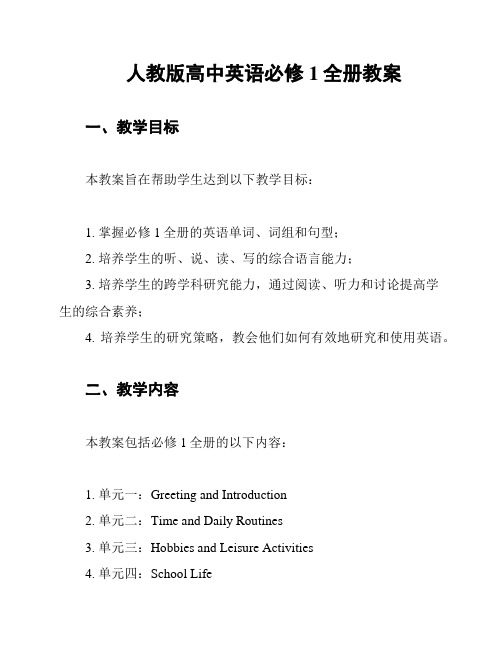
人教版高中英语必修1全册教案一、教学目标本教案旨在帮助学生达到以下教学目标:1. 掌握必修1全册的英语单词、词组和句型;2. 培养学生的听、说、读、写的综合语言能力;3. 培养学生的跨学科研究能力,通过阅读、听力和讨论提高学生的综合素养;4. 培养学生的研究策略,教会他们如何有效地研究和使用英语。
二、教学内容本教案包括必修1全册的以下内容:1. 单元一:Greeting and Introduction2. 单元二:Time and Daily Routines3. 单元三:Hobbies and Leisure Activities4. 单元四:School Life5. 单元五:Family and Relationships6. 单元六:Travel and Holidays每个单元的教学内容包括听、说、读、写的综合练,以及文化背景和研究策略的介绍。
三、教学方法本教案采用以下教学方法:1. 任务型教学:通过给学生一些具体任务,培养他们自主研究和合作研究的能力;2. 情境教学:将研究内容置于真实的生活情境中,帮助学生理解和使用英语;3. 多媒体教学:结合多媒体资源,提供丰富的听力、口语和阅读材料,激发学生的研究兴趣;4. 提问引导:通过提问引导学生思考和表达,激发他们的研究动力;5. 小组合作:鼓励学生进行小组讨论、合作研究,提高他们的沟通和合作能力。
四、教学评估本教案将通过以下方式进行教学评估:1. 课堂表现:观察学生在课堂上的参与程度、口语表达能力等;2. 书面作业:布置书面作业,检查学生对教学内容的理解和掌握程度;3. 小组项目:布置小组项目,评估学生的合作能力和综合运用能力;4. 课堂测验:定期进行课堂测验,测试学生的听力、阅读和写作能力。
五、教学资源本教案所需的教学资源包括:1. 教科书:人教版高中英语必修1全册;2. 多媒体资源:包括录音、视频和网络资源;3. 手机、平板电脑等电子设备:用于学生查阅和使用研究资源。
高一英语必修一教案范文5篇

高一英语必修一教案范文5篇学习一个多么熟悉亲切的名词。
从呱呱落地后我们便开始了欢乐多彩的学习旅程。
牙牙学语、懵懂入学我们一步一步登上学习阶梯。
下面是课件我为您推荐高一英语必修一教案范文5篇。
高一英语必修一教案最新范文1 教学准备教学目标1. 通过学生分享自己的旅游经历,用英语进行交流与表达。
2. 通过略读与找读,使学生获取文章主要信息,练习阅读技巧。
3. 通过小组讨论为旅游准备的物品,使学生用英语简单的语言实践活动。
教学重难点教学重点:利用阅读技巧,获取文章大意及细节教学难点:用英语交流并进行简单实践活动旅游需要准备的物品教学过程I、Warming Up:1. Id like to share my travelling e_perience with you,and would you like to share your travelling e_perience?2. The world has many great rivers. Have you been to these rivers?设计意图:大部分学生都喜欢旅游,老师谈谈自己旅游的经历,询问学生的旅游经历。
列举世界上的河流图片,让学生来欣赏认识美好的河流。
能有效地调动学生的学习积极性。
河流图片的展示,学生猜测河流的名字,唤起学生的学习兴趣以及对大自然的热爱。
II. Pre-readingHave you been to the Mekong River? What countries does the Mekong River flow through?设计意图:展示沿湄公河的地图,引起学生的兴趣,让学生观察地图,说出湄公河流经的国家,为随后的阅读做好了内容和词汇上的铺垫。
III. Reading1. SkimmingSkim the passage and find the main idea for each paragraphPara 1: DreamPara 2: A stubborn sisterPara 3: Preparation设计意图:略读:学生快速浏览课文,寻找相关信息并搭配段落大意。
高中英语必修1教案

高中英语必修1教案【篇一:新课标人教版高中英语必修1至5全套教案汇编(共五册)】高中英语必修1全册教案teaching aims: 1. 能力目标:a. listening: get information and views from the listening material;b. speaking: express one‘s attitude or views about friends and friendship in appropriate words.c. reading: enable the ss to get the main idead. writing: write some advice about making friend as an editor2. 知识目标:a. talk about friends and friendship; how to make friends; how to maintain friendshipb. use the following expressions:i think so. / i don‘t think so. i agree. / i don‘t agree. that‘s correct. of course not.exactly.i‘m afraid not. c. to enable the ss to control direct speech and indirect speechd. vocabulary: add point upset calm concern careless loose cheat reason list share feeling thought german series outdoors crazy moonlight purpose dare thunder entirely power according trust indoors suffer teenager advice quiz editor communicate situation habitadd up calm down have got to be concerned aboutwalk the dog go through hide awayset down a series ofon purpose in order toface to face according toget along with fall in love join in3. 情感目标:a. to ar ose ss‘ interest in learning english;b. to encourage ss to be active in the activities and make ss to be confident;c. to develop the ability to cooperate with others. 4. 策略目标:a. to develop ss‘ cognitive strategy: taking notes while listening;b. to deve lop ss‘ communicative strategies.5. 文化目标:to enable the ss to get to know different opinions about making friends from different countries.teaching steps: period one step1. warm-up1. ss listen to an english song auld lang syne.2. brainstorming: let ss say some words about friendship –honest, friendly, brave, humorous, funny, wise, kind,open-minded, responsible, helpful…. step 2. talk about your old friends1. ss talk about their old friends in junior middle school, talk about their appearance, personality, hobbies,etc.2. self-introduction step3. make new friendsstep 4. do a surveyss do the survey in the text ,p1 sep 5. listening and talkingdo wb p41 (talking). while ss listen to the material, ask them to take notes about the speaker‘s views of making friends.when ss make their conversation, ask them to try to use the following expressions. i think so. / i don‘t think so. i agree. / i don‘t agree.that‘s correct.of course not.exactly. i‘m afraid not. step 6. discussiondivide ss four in one group and each group choose a topic to discuss. there are four topics. topic 1: why do you need friends? make a list of reasons why friends are important to you.topic 2: there is a saying ―to have a good friend, you need to be a go od friend.‖ what do you think of the saying and howcan you be a good friend?topic 3: does a friend always have to be a person? what else can be your friend? why? topic 4: list some qualities of aperson who does not make friend easily. step 7. summary1. ask ss themselves to summarize what is friendship andwhat is the most important in making friends. 2. t shows more information about friendship and a poem about friendship.what is friendship?3. tell ss: make new friends and keep the old; one is silver and the other is gold. step 8. evaluationhomework:1. look up the new words and expressions in warm-up andpre-reading in a dictionary. 2. write a short passage about your best friend.period two readingstep1.warming upactivity1: suppose you have to stay indoors to hide yourselffor a whole year. you can never go outdoors, otherwise youwill be killed. you have no telephone, computer, or tv at home. how would you feel? what would you do?four students a group discuss with each other for 2 minutes. activity2: play a short part of the moviesstep2. predictingstudents read the title of the passage and observe the pictures and the outline of it to guess: who is anne’s best friend?what will happen in the passage?step3. skimmingstudents skim the passage in 2 minutes to get the main idea : who is anne’s best friend? when did the story happen?step4. scanningstudents work in pairs to find the information required below: annestep5. intensive readingstudents work in group of four to discuss the following open questions:1.why did the windows stay closed?2.how did annefeel?3.what do you think of anne?4.guess the meanings of ―spellbound‖, ― hold me entirely in their power‖ from the discourse(语篇,上下文).5.which sentences attract you in the passage?step6. activityfour students a group to discuss the situation:suppose you four have to hide yourselves for 3 months. during the three months, you will be offered the basic food, water and clothes. your group can take 5 things with you.what will you take? why? how will you spend the 3months?how will you treat each other and make friends ?step7.assignmenttask1.surf the internet to find anne’s diary and read some of it. print out a piece of the diary and write down your feelings after reading it on the page. we will share the pieces and your feelings with the whole class.task2.ex2.3on page3period threestep 1. warming upcheck the ss‘ assignment: task 2step 2. language points:step 3. learning about language1. finish ex.1, 2 and 3. on page 4.2. direct speech and indirect speech: ss do ex.1 and 2 on page 5. then let the ss themselves discover thestructures.step 4. practice using structures on page 42: ask the ss to use indirect speech to retell the story. step 5. assignmentfinish wb. ex, 1 and2 on page 41 and 42.period fourstep 1. revision check the ss‘ assignment. step 2. reading ss read the letter on page 6 notes:1. get along with2. fall in love step3. listeningss should take notes while they are listning.1. first listening: ss listen and answer the questions of part 2 on page 6.2. second listening: ss listen again and finish part 3 on page 6. step 4. listeningss listen to a story about anne and try to finish wb. ex 1 and 2 on page 43 and page 44. step 5. speakingss work in groups of four. design a questionnaire to find out what kind of friends your classmates are. they can use the quiz in the warming up to help them. step 6. assignment1. ss prepare the reading task on page 44.2. surf the internet and find some material about friendship in different countries. period fivestep 1. warming up ss say something about making friends and how to maintain friendship. step 2. listening ss listen to a short passage and fill in the blanks on page 41 (listening). step 3. reading1. first reading: ss read the passage about friendship in hawaii and finish wb.ex1.on page 45.2. second reading: ss read again and discuss the questions on page 45.3. ss share their material about friendship in different countries in groups, and then choose some groups toshow theirs in class.step 4. discussionwhat do you and your friends think is cool? ss look at the photos on page 46 and in groups of four talk about whether what they are doing is cool or not .ask ss to use the following sentences while they talk:i think that… is cool/ isn‘t cool because …. i think so. i don‘t think so. i agree with you. i don‘t agree with you. step 5. assignmentss collect some proverbs about friendship.period sixstep 1. pre-writing1. read a letter from a student called xiaodong.2. go over the advice on page 7 and be ready for writing. step 2. while-writingask the ss to write a letter to xiaodong as an editor and give him some advice. 1. ss make a list about the important information that they need. 2. ss begin to write the letter to xiaodong. 3. ss revise their letters by themselves.4. ss exchange their writing paper with their partners and correct the mistakes. (tense, spelling, letters,structures….)5. ss get back their own writing paper and write the letter again. step 3. post-writingchoose some students‘ writing paper and show in the class. ask the ss to correct the mistakes together and also learn from some good writings. step 4. writing for fun1. ss read the passage on page 7 by themselves.o write a few lines to describe their best friends or a person they know. 3. show some ss‘ writings in c lass. step5.assignmentdo wb writing task on page 46.period seventeachers can use this period freely.suggestion: teachers can use this period to let ss sum up what they have learned and explain what ss couldn‘t understand very well in this unit. teachers can also add more practice in this period to consolidate what the ss have learned. finally, ask the ss to finish checking yourself on page 47. it is very important to improve their learning.unit 3 going places(说课稿)高一上教学内容分析本单元的中心话题是“旅游”,可以说这是一个世界性的时尚话题,随着经济发展、社会进步、人们生活水平的提高,旅游作为现代人的一种生活方式,越来越被更多的人们所接受与喜爱。
新课标高一英语必修一全册教案
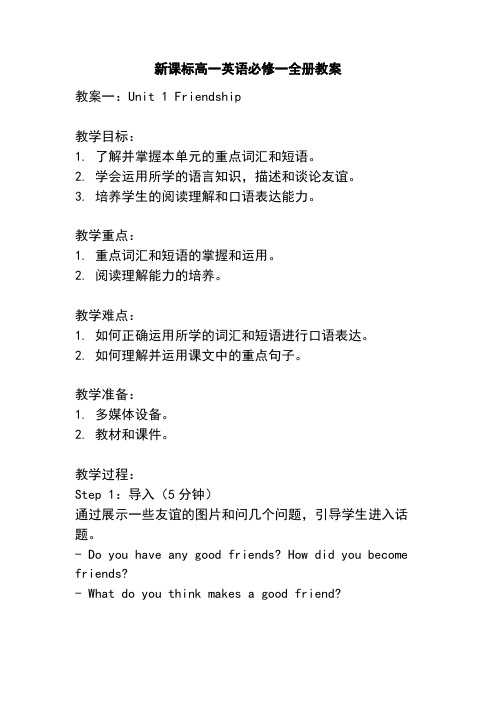
新课标高一英语必修一全册教案教案一:Unit 1 Friendship教学目标:1. 了解并掌握本单元的重点词汇和短语。
2. 学会运用所学的语言知识,描述和谈论友谊。
3. 培养学生的阅读理解和口语表达能力。
教学重点:1. 重点词汇和短语的掌握和运用。
2. 阅读理解能力的培养。
教学难点:1. 如何正确运用所学的词汇和短语进行口语表达。
2. 如何理解并运用课文中的重点句子。
教学准备:1. 多媒体设备。
2. 教材和课件。
教学过程:Step 1:导入(5分钟)通过展示一些友谊的图片和问几个问题,引导学生进入话题。
- Do you have any good friends? How did you become friends?- What do you think makes a good friend?Step 2:词汇和短语学习(10分钟)通过多媒体展示和示范,教授本单元的重点词汇和短语。
- friendship, loyal, trust, support, companion, betray, argue, forgive, appreciate, value, make friends, keep in touch, get along with, fall out with, make upStep 3:阅读理解(20分钟)教师通过多媒体展示,让学生阅读课文,并进行理解。
- 学生阅读课文,并回答一些问题,如:What is the main idea of the passage? What does the author think about friendship? How does the author describe a good friend?Step 4:语言运用(15分钟)通过讨论和练习,让学生运用所学的语言知识进行口语表达。
- 讨论题目:What qualities do you think a good friend should have? Give examples to support your ideas.- 练习:学生分组进行角色扮演,模拟对话中的情景。
高一英语必修一unit1教案【5篇】
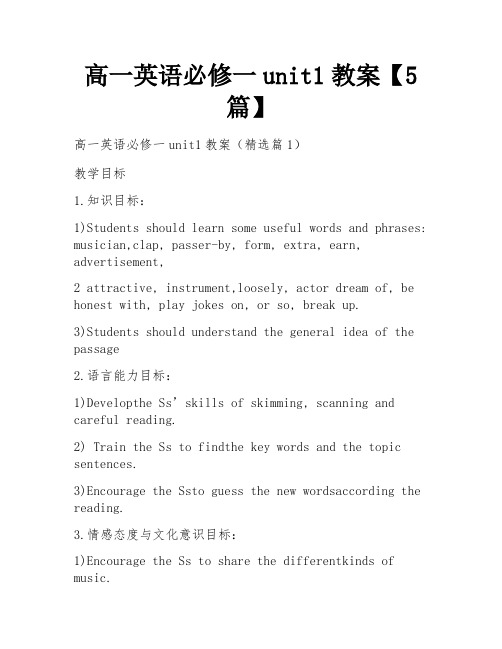
高一英语必修一unit1教案【5篇】高一英语必修一unit1教案(精选篇1)教学目标1.知识目标:1)Students should learn some useful words and phrases: musician,clap, passer-by, form, extra, earn, advertisement,2 attractive, instrument,loosely, actor dream of, be honest with, play jokes on, or so, break up.3)Students should understand the general idea of the passage2.语言能力目标:1)Developthe Ss’skills of skimming, scanning and careful reading.2) Train the Ss to findthe key words and the topic sentences.3)Encourage the Ssto guess the new wordsaccording the reading.3.情感态度与文化意识目标:1)Encourage the Ss to share the differentkinds of music.2)Improve the cooperation and share among the students.教学重难点1、教学重点:a.To understudend the passage better b.To find the main idea of eachparagraph2、教学难点:a.Master the reading ability b.Develop the skills ofreading教学过程教学设计本节课共45分钟,具体教学步骤如下:Step I Leading-in播放一段小视频,内容为歌曲 If you arehappy的英文版本,通过介绍演唱乐队twins引出本单元话题。
高中英语必修一教案设计模板(共20篇)

高中英语必修一教案设计模板(共20篇)第1篇:高中英语必修一第一单元教案Unit 1 Friendship I.Warming Up 1.good: adj.好心的,仁慈的,乐于助人的 be good to sb.: 对某人好e.g.She’s good to me.I am good to my friends.be good to do sth.: 仁慈的,乐于助人的e.g.Would you be good enough to carry this for me?good的固定搭配:①be good at sth.: 擅长做某事 e.g.Tom is good at swimming.I am not good at English.②be good for sb./sth.: 有益于某人/某事e.g.Is this kind of food good for us?Sunshine is good for your plants.③be g ood for sth.: 适合干某事、适宜于某事 e.g.She would be good for the job.This beach is good for swimming but bad for surfing.→be bad for:a.对……无益处 b.不适于……2.add up: 把……全加在一起e.g.Add up all these figures and you will know the result.add 的固定搭配add to: 加,增加,添加e.g.Fireworks added to the attraction of the festival night.add sth to: 把某物添加到…… e.g.She added some salt to the soup.Please add some sugar to the coffee.add up to: 合计是……e.g.All the money adds up to 1000 dollars.3.get sth.+ 过去分词e.g.You’d better get the car repaired.Do you know how to get it colored?4.upset: adj.不安的,心烦意乱的e.g.I was very upset becauseI failed the exam.vt.使心烦意乱,使不安e.g.His rude behaviors upset her.Don’t up set yourself.5.be concerned about: 为……担心;关心,关注e.g.We are all concerned about her safety.I’m very concerned about his attitude to my work.concerned: adj.关心的,担心的,忧虑的 concern: v.对……有关系,影响e.g.This concerns the healthy growth of the children.Pay attention to what concerns you.6.should have done: 本应该做某事(虚拟语气,意指过去应该做的事情,却没有做,含有遗憾、职责等意味)e.g.You should have told me the news earlier.We should have stopped him.I should have thought of that.→shouldn’t have done: 本不应该做(指过去不应该做的事情,却做了)e.g.He shouldn’t have come at all.You shouldn’t have told her the news.第2篇:高中英语必修一unit1教学设计高一英语必修一教案:Unit11.能力目标:a.Listening: get information and views from the listening material;b.Speaking: expre one’s attitude or views about friends and friendship in appropriate words.c.Reading: enable the Ss to get the main idead.Writing: write some advice about making friend as an editor2.知识目标:a.Talk about friends and friendship;how to make friends;how to maintain friendshipe the following expreions:I think so./ I don’t think so.I agree./ I don’t agree.That’s correct.Of course not.Exactly.I’m afraid not.c.to enable the Ss to control direct speech and indirect speechd.vocabulary: add point upset calm concern carele loose cheat reason list share feeling thought German series outdoors crazy moonlight purpose dare thunder entirely power according trust indoors suffer teenager advice quiz editor communicate situation habitadd up calm down have got to be concerned about walk the dog go through hide away set down a series of on purpose in order to face to face according to get along with fall in love join in3.情感目标:a.To arose Ss’ interes t in learning English;b.To encourage Ss to be active in the activities and make Ss to be confident;c.To develop the ability to cooperate with others.4.策略目标:a.To develop Ss’ cognitive strategy: taking notes while listening;b.To develop Ss’ communicative strategies.5.文化目标:to enable the Ss to get to know different opinions about making friends from different countries.Teaching steps:step1.lead-in1.let students talk about their summer holidays and their feelings.then get them to talk about friends, such as old friends in junior middle school, about their appearance, personality, hobbies, etc.poible questions:(1)how did you spend your summer holidays? how did you feel?(2)what do you think of our new school? do you like it? could you say something about it?(3)do you like making friends? how many good friends do you have? what are they like? step 2.brainstorming(1)what qualities do you think a good friend should have?honest, loyal, friendly, brave, humorous, funny, wise, kind(2)what proverbs do you know about friends and friendship?eg: a friend in need is a friend indeed.friends are just the people who share your happine and sorrow.to have a friend, you need to be a good friend.a life without a friend is a life without the sun.a man who has friends must show himself friendly.step3.pre-reading1.why do you need friends?2.do you think a diary can become your friend? why or why not?3.what do you know about world war ⅱ?(show pictures about world war ⅱ on ppt)let students answer the above questions and give them some background information about the author anne frank, and show them some pictures of her.step4.fast readinglet students skim the text and answer these questions.1.who was anne’s best friend? 2.why did she make friends with it?3.when did the story happen? step5.careful reading 1.listening to the tape with 3 questions:(1)what did she do?(2)why did she do that way?(3)how did she enjoy herself? 2.summarize the main idea for each paragraph in one sentence.(students may discu it in pairs and they are supposed to produce a concise answer.)3.do exercise 2 on page 3.step 6.post-reading discuion: 1.divide the whole cla into 8 groups and elect a group leader of each group.(1)why did anne write such a diary?(2)what's anne's tone? in other words, is she angry, sad, happy or frightened ?(3)thestructure of this paage: narrative writing.what phrases or sentences are used to describe a situation ,a problem ,or a person or a place ? 2.talking about friends and friendship(1).there are many proverbs about friends and friendship.choose the one you agree with and explain why, then choose one you disagree with and explain why.a friend in need is a friend indeed.friends are like wine;the older, the better.a friend to all is a friend to none.false friends are worse than open enemies.walking with a friend in the dark is better than walking alone in the light.(2).we have talked about friends and friendship today, can you write one or two sentences to expre your understanding of friends and friendship.step 7.homework e the internet to find out more about some background knowledge of world war and anne’diary.2.write a diary about something you met.第3篇:高中英语必修一unit3 教学设计必修一第三单元 Travel Journal一、教学内容介绍该课是根据高一英语新教材第一模块第三单元Travel Journal中课后学生用书中的Writing Task扩展而成的一节活动课,是新课程教学实践中一次较为大胆的尝试。
英语必修一教案
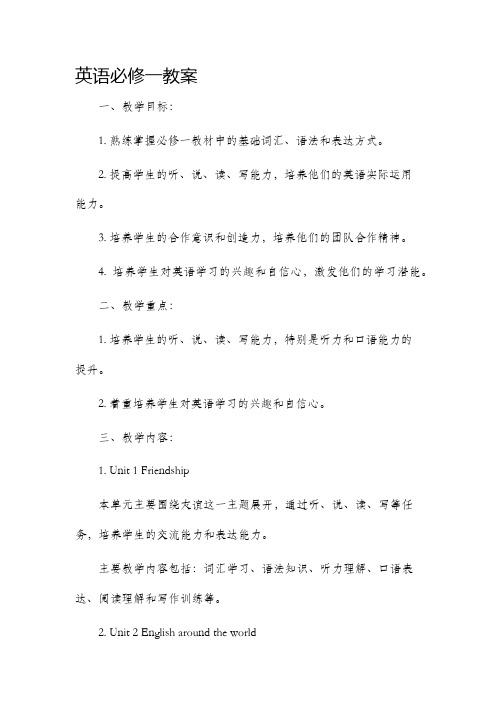
英语必修一教案一、教学目标:1. 熟练掌握必修一教材中的基础词汇、语法和表达方式。
2. 提高学生的听、说、读、写能力,培养他们的英语实际运用能力。
3. 培养学生的合作意识和创造力,培养他们的团队合作精神。
4. 培养学生对英语学习的兴趣和自信心,激发他们的学习潜能。
二、教学重点:1. 培养学生的听、说、读、写能力,特别是听力和口语能力的提升。
2. 着重培养学生对英语学习的兴趣和自信心。
三、教学内容:1. Unit 1 Friendship本单元主要围绕友谊这一主题展开,通过听、说、读、写等任务,培养学生的交流能力和表达能力。
主要教学内容包括:词汇学习、语法知识、听力理解、口语表达、阅读理解和写作训练等。
2. Unit 2 English around the world本单元主要围绕英语在世界范围内的使用情况展开,通过听、说、读、写等任务,培养学生的跨文化交流能力和写作能力。
主要教学内容包括:词汇学习、语法知识、听力理解、口语表达、阅读理解和写作训练等。
3. Unit 3 Travel journal本单元主要围绕旅行这一主题展开,通过听、说、读、写等任务,培养学生的阅读和写作能力。
主要教学内容包括:词汇学习、语法知识、听力理解、口语表达、阅读理解和写作训练等。
4. Unit 4 A charity walk本单元主要围绕慈善活动这一主题展开,通过听、说、读、写等任务,培养学生的合作能力和表达能力。
主要教学内容包括:词汇学习、语法知识、听力理解、口语表达、阅读理解和写作训练等。
四、教学方法:1. 多种教学方法相结合,如情景法、交际法、任务型教学法等。
2. 通过小组讨论、角色扮演、听力练习、口语对话等活动,培养学生的实际应用能力。
五、教学过程:1. 导入通过图片、录音或视频等形式,引入本课的话题,激发学生对英语学习的兴趣。
2. 词汇和语法学习通过教师的示范和学生的模仿,掌握本单元的词汇和语法知识。
3. 听力训练通过听力材料,培养学生的听力理解能力和语音感知能力。
高一必修一英语教案(集锦12篇)
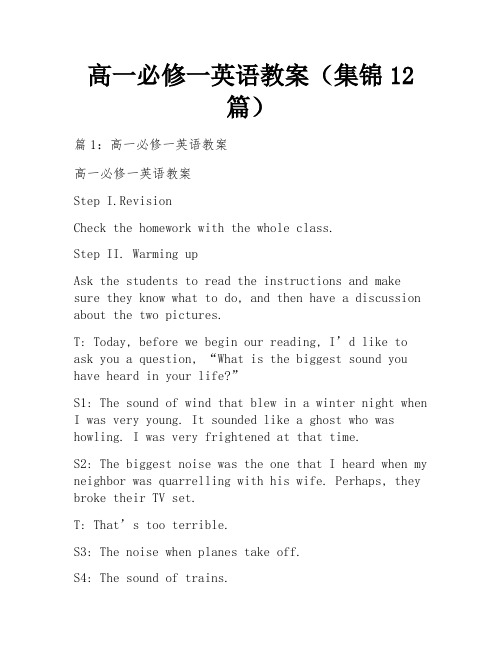
高一必修一英语教案(集锦12篇)篇1:高一必修一英语教案高一必修一英语教案Step I.RevisionCheck the homework with the whole class.Step II. Warming upAsk the students to read the instructions and make sure they know what to do, and then have a discussion about the two pictures.T: Today, before we begin our reading, I’d like to ask you a question, “What is the biggest sound you have heard in your life?”S1: The sound of wind that blew in a winter night when I was very young. It sounded like a ghost who was howling. I was very frightened at that time.S2: The biggest noise was the one that I heard when my neighbor was quarrelling with his wife. Perhaps, they broke their TV set.T: That’s too terrible.S3: The noise when planes take off.S4: The sound of trains.T: Good! I agree that all of them are big sound. But did you once heard the sound that the heaven falls and the earth cracks, in Chinese it is 天崩地裂?Ss: No, we have no chance to hear that.T: If there is a sound like this, what is it?S5: When someone hears something unexpected and terrible. For example, when one of his loved families dies, he will feel this sound.T: Terrific! You are using a literary way to express the sound.S6: When an earthquake happens.T: Great! I have waited for this answer for a long time. Today we’ll learn something about earthquakes.I think most of us have heard of earthquakes. Can you imagine how terrible it is ?S7: The earth is shaking . All the buildings will fall down.S8: Many people will die. And perhaps many childrenwill lose their parents.T: Yeah, earthquakes are disasters to everybody. Now look at the two pictures of Tangshan and San Francisco. Can you describe what you see in the pictures?S1: Tangshan is a beautiful city. It has beautiful gardens, broad roads and some tall buildings.S2: From the picture of San Francisco,I can see thatit is a very big city. There are many tall buildings thickly standing on the earth. I think the population of the city is very large.T: Good! What will happen if there has been a big earthquake in these two cities? Work in pairs and discuss it. Then I’ll ask so me of you to show your opinion.Step III.Pre-readingThere are two questions in this part. Both are very interesting. The first one can more or less reveal the students’ values; while the second one can enlarge their imagination. No matter what their answers are, as long as they have given careful thoughts to the situations, their answers should be good.T: Now, let’s look at the pictur es. What are the predictions of an earthquake?S1: Before an earthquake animals will bee nervous. Cows, pigs, horses and dogs will be upset. And people can see mice running about. If the earthquake happens during winter, people can even see snakes.T: Terrific! Where did you get this knowledge?S1: From geography. I like it.T: good. Sit down please.S2: Madam, I don’t know the meaning of the picture with two women.T: It doesn’t matter. You will know it soon after reading our text. OK. Imagine there is an earthquake now, and your home is shaking, at this moment you have no time to take any other things but one, what will it be?S3: I’ll take all my money. People can’t live without money.S4: I will take as much water as possible. Because it is said that people can keep alive for nearly 7 days by drinking without any foodS5: In that case, I’d rather take some apples, sothat besides drinking, I can also eat.S6: I will carry my grandma. She is my most loved person in this world. She brought me up.T: What a dutiful child you are! I’m very glad to hear that. Sit down please! It seems that all of you know what you should do during an earthquake. OK. Let’s read our text, and see what it tells us.Step IV.ReadingIn this part, teacher should ask the students to read the passage quickly for the first time to get the general idea of the passage. Ask them to pay attention to the first sentence of each paragraph. This can help them finish exercise3 in Comprehention. It isabout the main idea of each paragraph. Then ask themto read the text again carefully to obtain some details. Before reading for the second time, show some questions on the screen, and let the students read the questions first. These questions can guide them to have a good understanding about the text. They canalso make preparations for Exs1-2,which are about details.SkimmingT: At first I’d like to read the text quickly to get the general idea of the article. While reading, you should pay attention to the sentence of each paragraph.T: Have you got the general idea of the text?Ss: Yes.T: What is it?S1: There is no quick answer to this question . Areyou suggesting us that the general idea is the mixture of the first sentences of each paragraph?T: Sure.S1:OK. That’s easy. The main idea of the p assage is some signs of the earthquake, and what would happen during the quake.T: Good, sit down please. In fact, while we are answering the questions, we have involved the sequence, the functional item for this unit. (Teacher writes theword on the blackboard ) Do you understand the meaning of the word?Ss: No.T: Sequence means the order of the events. It can tell us which event happens first, and which happenslater. Do you know the sequence that is used in our text?S3: Yes. At first, the text tells us something that happened before the quake, then it tells us the things that happened during the quake and at last it tells us the things that happened after the earthquake.T: Quite right! Now please look at the screen, these are the first sentences of each paragraph. Read them and think if they are the main idea of the text. If necessary, you may make some changes to make more exact.Teacher shows the screen and gives a little time to think it over.1.Strange things were happening in the countryside in the northeast Hebei.2.The disaster happened and caused a lot of loss.3. All hope was not lost.Careful readingT: Now, it’s time for us to read the text carefully. But before reading, you should read some questionsfirst. These questions may help you get some information quickly and easily. Now look at the screen, and read the questions.Show on the screen1.What natural signs of a ing disaster were there?2.Can you think of some reasons why these signs weren’t noticed?3.What events probably made the disaster worse?4.What situations probably made the disaster worse?5.How were the survivors held?Step V.ExtensionShow the questions on the screen.1.From whose point of view are events described? Howdo you know?2.What is the mood of this passage? How is it created?3.Why do you think the writer chooses to express his feelings about the quake rather than simply reporting what had happened?4.Why is the title A NIGHT THE EARTH DIDN’T SLEEP?5.What does the sentence “Slowly, the city began to breathe again.” mean?Answers:1. He uses third-person to describe the quake. His description is very objective. For example, the second sentence in the third paragraph. The writer says: “Everywhere they looked nearly everything was destroyed.” The writer uses they instead of we.2.The mood is serious and a bit sad. It is created by giving details of how many people and animals were killed or injured, and how many buildings were destroyed.3.Although the writer was not there, he felt sad for the people of Tangshan. He knows that some personal feelings will make the reading more interesting.4.I think the reason is that, as usual, night is the time to sleep, and night should be safe and quiet. But that night everything changed. The writer uses A NIGHT THE EARTH DIDN’T SLEEP as a title to show howterrible and how unusual the night was.5.Here we can see that the writer pared the city to a person who suffered a lot in the disaster. He felt her pain, and he worried about her. So when he said that people came to help her, we can feel his feelings to the city. The city will not die, she has hope and she can recover from the pain.Step VI ComprehendingAnswers to Exx1-31.1. C2. E3.B4.D5.A2.1. The walls of the villages wells had cracks in them.2 .Roads got huge cracks3. Brick buildings were destroyed.4. The army helped the survivors.5. Shelters were put up for those with no homes.3.1. Strange things were happening in the countryside in northeast Hebei..1.The disaster happened and caused a lot of loss.2.All hope was not lost.Step VII Homework课后反思:总体感觉上,本节课上得比较成功,心情愉快。
高一英语必修一教案范文5篇
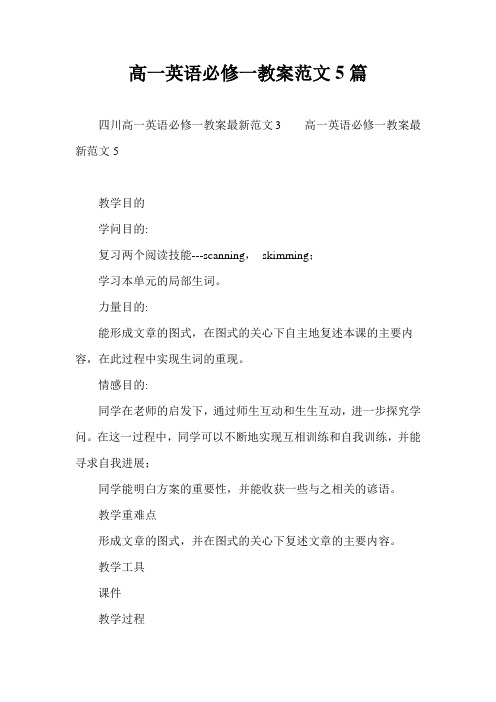
高一英语必修一教案范文5篇四川高一英语必修一教案最新范文3高一英语必修一教案最新范文5教学目的学问目的:复习两个阅读技能---scanning,skimming;学习本单元的局部生词。
力量目的:能形成文章的图式,在图式的关心下自主地复述本课的主要内容,在此过程中实现生词的重现。
情感目的:同学在老师的启发下,通过师生互动和生生互动,进一步探究学问。
在这一过程中,同学可以不断地实现互相训练和自我训练,并能寻求自我进展;同学能明白方案的重要性,并能收获一些与之相关的谚语。
教学重难点形成文章的图式,并在图式的关心下复述文章的主要内容。
教学工具课件教学过程StepsTeachers activityStudents activityAimsStep 1Show and tell the students the learning goals for them and make possible e_planationsStudents listen to the teacher and have an idea of what they are going to learn in this class.To make the students know what they are to learn in this classStep 21〕. Show some pictures with beautiful scenery2〕Ask the students two questions:Are they attractive?Where do you want to travel? I dream about traveling1.〕Students appreciate those pictures2〕Students answer teachers questions and practice the sentence pattern "I dream about traveling in/to'1〕. To arouse students interest2〕To practice a sentence patternStep 31〕. Show the title of the reading passage2〕. Ask the students whether this passage is about the whole process of the journey.3〕. Ask the students how to skim.4〕Tell the students the skill of skimming on the screen1〕Students answer the question after they read the subtitle of this part.2〕. Students tell how to skim.1〕To make the students pay attention to the subtitle,which can tell the main idea of the passage.2〕To review how to skimStep 41〕Ask the students to skim moreto find out the main idea of each paragraph.1〕Students tell the main idea of each paragraph1〕To practice how to skimStep 5With four questions,teacher asks the students to scan paragraph 1 Ask students how the scanShow the skills of scanning on the screenStudents scan paragraph 1,and answer the four questionsStudents tell how to scanTo review how to scanTo practice how to scanStep 61〕Ask the students to scan paragraph 2 and find out what different attitudes Wang Kun and Wang Wei have,and then finish the table 1〕Students scan paragraph 2 and finish the table1〕To practice how to scanStep 71〕Provide the students with a picture which describes a geographic word as well as a few sentences about the flow of the Mekong river on each slide and ask them to read the sentences.2〕Ask the students to match each geographic word to the proper meanings1〕Students read the sentences loudly together and look at the pictures and the related geographic words in the meanwhile.2〕Students do the matching work1〕To better know how the Mekong river flows2〕To help the students better learn the geographic words which are new to them3〕To check how the students understand the new wordsStep 8Review the structure of the passage together with the students and show some key words on the screenProvide the students with some words and phrases which are the new words in this unitAsk them to retell the main content of the passage in groupsWith the teacher,students review the structure of the passageRetell the main content of the passage in groupsTo help students form the schema of the passage by reviewing the structure of itTo know the content of the passage better as well as to create more chances for the students to use the new wordsStep 91〕Ask the students what they learn from the story2〕Give the students some useful and related proverbs1〕Students share their opinions with the group members what they have learned from the story.2〕Students read the proverbs loudly together.1〕To encourage students to form their own views and share them with others2〕To learn some useful proverbsStep 101〕Summarize this class by showing the learning goals again2〕Homework1〕Students review what they have learned by reading the learninggoals on the screen.1〕To help students review what they have learned in this class。
- 1、下载文档前请自行甄别文档内容的完整性,平台不提供额外的编辑、内容补充、找答案等附加服务。
- 2、"仅部分预览"的文档,不可在线预览部分如存在完整性等问题,可反馈申请退款(可完整预览的文档不适用该条件!)。
- 3、如文档侵犯您的权益,请联系客服反馈,我们会尽快为您处理(人工客服工作时间:9:00-18:30)。
高中英语必修一教案高中英语必修一教案Unit 1 Friendship1.Teaching aims and demands类别课程标准要求掌握的项目话题Friends and friendship; interpersonal relationships词汇add point upset ignore calm concern loose cheat reason list share feeling Netherlands German outdoors crazy nature purpose dare thunder entirely poweraccording trust indoors suffer teenager advice questionnaire quiz situation editorcommunicate habitadd up calm down have got to be concerned about walk the dog go through hide away set down a series of on purposein order to face to face according to get along with fall in lovejoin in功能态度(attitudes)Are you afraid that---?I’ve grown so crazy about---I didn’t dare---2. 同意和不同意(agreement and disagreement)I agree. I think so. Exactly.I don’t agree. I don’t think so. I’m afraid not.3.肯定程度(certainty)That’s correct. Of course not.1.Suggested teaching notes1). Analyses of the teaching contentsThis unit is about friendship, and nearly all the teaching materials center on it. Warming up---The questionnaire leads students to think and talk aboutfriendship, get to know the problems between friendsand seek solutions, which makes preparations for thefurther teaching in topics, background and vocabulary.Pre-reading---The questions prompt students to think critically aboutfriends and friendship in reality, alerting them to the factthat besides people, a diary can be a friend, too.Reading--- The diary by the Jewish girl Anne gave a glimpse of her life during her family’s shelter in Amsterdam from the Ger manNazis’ killing in world war 2. she treats the diary as her best friend, and in it reveals her longing for a normal life and close contact with nature, whichhelps her get through the days.Comprehending---It helps students further understand the text by doingmultiple choices, questions and answers, andmatching.Learning about language---It teaches the important expressions andstructures and grammar: direct and indirectspeeches.Using language---The two letters, listening, questionnaire design, letterwriting and fun writing prepares students to furthertalk about friendship, especially the problems withmisunderstanding, and unfriendliness, thusstrengthening students’ abilities to practicelanguage, discover, and solve problems.Summing up---It summarizes the whole contents of this unit from theaspects of topics, vocabulary and grammar.Learning tip--- This part encourages students to form the habit of writinga diary.Integrating skills--- The text introduces the way Hawaiians expressfriendship, to get students to realize the culturaldifferences in the values of friendship in additionits importance in all cultures.2) Making of the teaching planThis unit centers on friends and friendship, exploring different types of friendship with particular attention to that one can develop with oneself, i.e., the comfort and support one seeks from an imaginary friend. Students are expected to come to be truly aware of the qualities and conducts that make a good friend, display and develop the ability to cope with misunderstanding, conflicts and problems related to friendship, and give advice on it. The concept that even an ordinary thing can be a friend should break down the traditional belief in the interpersonal nature of friendship. Also, the comparison of similarities dissimilarities in friendship comprehension between the East and the West leads students to know better the values of friendship in Westerns’ eyes. All in all, this unit promises to unveil the true essence of friendship and helps students to lead a more friendly and harmonious life. Thus, based on the theme, contents and teaching objectives, the whole teaching procedures can fall into five periods as follows:3. Teaching plans for each periodPeriod 1 Warming-up and Speaking1. Teaching objectives:1) Target languageI (don’t) think…… I (don’t) think so. I (don’t) agree.I believe…… That’s correct. In my opinion, ……2) Ability goalsa.Describe your friends in Englishb.Figure out the problems between friends and then find different ways to solve theproblems.3)Learning ability goalsa.To encourage students to think and talk about friends and friendship by using somephrases and structures.b.To learn to solve problems that may occur between friends.c. To cultivate the students to form the good habit of learning English in Senior MiddleSchool.2. Teaching important points:e the given adjectives and sentence structures to describe one of yourfriends.b.Learn to evaluate friends and friendship.3. Teaching difficult points:a.Work together with partners and describe one of your good friends.b.Discuss with partners and find out ways to solve the problems.4. Teaching methodsa.Task-based teaching and learningb.Cooperative learningc.Discussion5. Teaching aids:CAI6. Teaching procedures and ways:Step 1 Lead-in and Warming-upBefore the lesson, the teacher can arouse the students’ interests by showing a video of Auld Lang Syne .At the beginning of the first class, we can get the students to talk about their summer holidays. The students can talk freely as they like.1.How did you spend your summer holidays? How did you feel? What didyou do in your summer holidays? What did you do in your spare time?2.What do you think of our new school? Do you like it? Could you saysomething about it?3.Do you like making friends? How do get in touch with your friends? Doyou have many friends? Where are they now? Do you have any oldfriends in our school? Have you made any new friends in our class?Step 2 Think it over1. Give a brief description of one of your friends. The following phrases andstructures may be helpful:His/Her name is ……He /She is …… years old.He /She likes …… and dislikes ……He /She enjoys …… and hates……He /She is very kind/friendly/……When /Where we got to know each other.2. What types of friendship do you have? Please tick them out. Then fill in theblanks.girl friends boy friends pen friendslong -distance friends friends of the same agee-friends (friends over the internet) friends across generationsunusual friends like animals, books……1).______ is /are most important to you.2). You spend most of your free time with ____.3). You will share your secrets with _____.4). When in trouble, you will first turn to _____.Step 3 Make a survey1. List some qualities of a good friend or your ideal friend. Have the students get into groups of four to find out what each has listed.Tell your partner your standards of good friends by using the following structure:I think a good friend should (not) be……In my opinion, a good friend is someone who……1.Have a member of each group report on what their lists have in common and listthem on the board.2.Ask the class whether or not they agree with all the qualities listed.3.Then have the students do the survey in the textbook.4.Have the students score their survey according to the scoring sheet on page 8.5.The teacher ask some students how many points they got for the survey and assesstheir values of friendship:Step 4 Talking and sharing( work in pairs)1. If your best friend does something wrong, what will you do?Try to use the following phrases:I (don’t) think…… I (don’t) think so.I (don’t) agree. I believe……That’s correct. In my opinion, ……2. What is a friend?A British newspaper once offered a prize for the best definition(定义) of a friend. Ifyou were the editor, choose the best one from the following entries(条目), and explain why.One who understands my silence.A friend in need is a friend indeed.Friends are just the people who share your happiness and sorrow. When you look at your watch at 4 am, but still know you can call them and wake them up, and they’ll still want to talk to you ,that’s friendship. To have a friend, you need to be a good friend.Step 5 Group work (output)The teacher can give each group one of these questions below to talk about. Then let the class share their ideas. It’s better to stimulate the students to express their own opinions about these questions.1.Do you think it is a good idea to borrow money from your friend?Why and Why not?2. What factors may cause the breakdown of a good friendship?3. What can be your unusual friend besides human beings? And why?Step 6 Homework1.Write down a short passage about your ideas /the factors/your unusual friends.2.Prepare for the new lesson.Period 2 Reading “Anne’s Best Friend”1. Teaching objectives:1) To develop the students’ reading ability, learn to use some reading strategies suchas guessing, key sentences, skimming and so on;2). To get the students to realize the importance of friends and friendship, and to telltrue friends from false friends;3). To grasp some useful words and expressions in this passage, such as on purpose,be crazy about etc.;4). To learn the writing style of this passage.2. Teaching method: Task-based teaching3). Teaching procedure:Step 1.Pre-reading1. Please enjoy three pieces of music and find out what they are about.2 .Why do you think friends are important to you?3. What do you think a good friend should be like? List the good qualities a goodfriend should have .4. Have you ever considered making friends with animals, plants or even an object?Why or why not?Step 2.Reading1. Try to guess what Anne’s friend is and what the passage is about by reading thetitle and having a quick at the pictures in this passage without reading it.2. Skimming the first two paragraphs to confirm your guessing.1) What was Anne’s best friend? Why did she make friends with it?2) Did she have any other true friends then? Why?3) What is the difference between Anne’s diary and those of most people?4) Do you keep a diary? What do you think most people set down in their diaries?5) We are going to read one of Anne’s diaries .but before reading ,can you tell me what the diary is about with the help of one key sentence in the 2nd paragraph?3. Reading of Anne’s diaryHow she felt in the hiding placeTwo examples to show her feelings thenStep 3.Post-reading1.What would you miss most if you went into hiding like Anne and her family?Give your reasons.2.Group workWork in groups to decide what you would do if your family were going to be killed just because they did something the Emperor did not like.Where would you plan to hide?How would you arrange to get food given to you every day?What would you do to pass the time?------3. Discovering useful words and expressionsStep 4.Talking about friends and friendship1.There are many proverbs about friends and friendship. Choose the one you agreewith and explain why, then choose one you disagree with and explain why.2. We have talked about friends and friendship today, can you write one or twosentences to express your understanding of friends and friendship.Step 5.Homework:1. Interview a high school student, a businessman, a police officer and a housewifeto find out their opinions about friends and friendship. Write a report to share it with the whole class.2. Describe one of your best friends following the writing style of this passage.Ending: Let’s sing this song about fr iends togetherPeriod 3 Grammar1.Teaching objectivesLearn to use direct speech and indirect speech2. Teaching important pointSummarize the rules of Direct Speech and Indirect Speech.3. Teaching difficult pointLearn about the special cases in which the tenses shouldn’t be changed.4. Teaching methodsDiscussing, summarizing and practicing.5.Teaching proceduresStep1 Lead inT: In the last lesson, we learned Anne Frank’s story. She is telling her stories to two of her friends—you and Tom. Tom has something wrong with his ears, so you have to repeat Anne’s sentences, using indirect speech. Sometimes you explain Tom’s sentences to Anne.“I have to stay in the hiding place.” said Anne. →Anne said she had to stay in the hiding place.“Do you feel sad when you are not able to go outdoors?” Tom asked Anne. →Tom asked Anne if/whether she felt sad when she was not able to go outdoors.“I don’t want to set down a series of facts in a diary,” said Anne.→Anne said that she didn’t want to set down a series of f acts in a diary.“What do you call your diary?” Tom asked. →Tom asked what she called her diary.Ss go on this topic by themselves.Step2 GrammarT: Now let’s look at these sentences again. If we want to change Direct Speech into Indirect Speech, what should be changed?Ss discuss by themselves.Ss: sentence structures, tenses, pronouns, adverbials of time and place and verbs should be changed.T: Quite right. Look at the form on the screen. These are the rules...Step3 practice1.T: Turn to Page 5. Please change the following direct speech into indirect speechand indirect into direct...Step4 Correcting mistakesT analyses the common mistakes Ss have made during the practice.T: Now let’s look at the screen and pay attention to these sentences. Choose t he right sentence and tell me why the other one is wrong.Step5 A gamePlay a guessing game “who is my secret friend?” One student comes to the front with his partner.The rest students ask him questions while his partner changes them into indirect speech. In the end, the person who has guessed the right answer can come to the front to take the place of the first student .So the game goes on.Suggested sentences:Can your friend speak?What does he/she wear today?Is he/she tall or short?What do you and your friend do in your free time?Do you quarrel with each other?...Step6 HomeworkDo Exercise1 on Page 42. Here is another page of Anne’s diary. Read it through and then use indirect speech to retell the story.Period 4 Integrating skills“Friendship in Hawaii”1. Teaching objectives:To learn about ways of showing friendship in Hawaii and share their opinions on friendship. Because it is a lesson of integrating skills, Ss are also asked to write sentences on friendship.2. Teaching procedures:Step1 Lead-in1. Talk about different ways of showing friendship of minority groups in China.2. Compare Chinese ways of showing friendship with Western ways. And discusswhy there is a big difference. Therefore, show the sentence: Every culture has itsown ways to show friendship.3. Ask students if they can think of any place in the world where Chinese andWestern cultures live side by side. They may think of Hongkong, Macao, Singapore.And the teacher will add one more -------Hawaii.Step2 Fast reading1. It is said that Hawaii is a place where the East truly meets the west. Consider howpeople show their friendship in Hawaii.Show a picture and find the information from the textbook. ( by giving “leis” to one another.)Explain what is a “lei”.2. Read fast and find out more ways to show friendship in Hawaii to fill in the form.3. According to the form, ask them to consider what friendship is in Hawaiians.Step 3 Careful reading1.Read the 2nd paragraph carefully and ask “Why do many differ ent peoples callHawaii their home?”( Hawaii is a place where people make one big community from many smaller communities. It means Hawaii has a rich cultural diversity.)Step 4 Writing task1.Show proverbs about friends and friendship. Explain them and ask Ss to choosesome they agree with and some they disagree with and explain why.2.Discuss with their partner and try to write some similar sentences to show theiropinions on friendship.Step 5 HomeworkSurf the Internet to collect materials like poems, stories about friendship. And share them with your friends.Period 5 Listening & Writing1. Teaching objectivesTo practise students’ listening ability.To practise students’ writing skills of how to offer advice.To improve students’ ability to help o thers solve problems.2. Teaching procedure(Analysis: Listening and writing are expansion of the topic of the text. Listening is about Lisa’s problem of making a friend with a boy. She asks Miss Wang for advice. Through listening and exercise, students learn how to give advice and the skill of giving advice. And also let them think about the problem of boy’s making friends with girls and girls with boys. And then design a task to ask students to give advice according to the different problems to practise their ability to solve the problems. All of these lay the foundation for the next task writing. In this way, students feel that they have information to put out. And writing makes for the improvement of students’ writing ability, strengthening their comprehension of friendship.)Step 1 Lead-inDo you remember what Ann’s best friend is?Is it a man or a thing?Have you seen the film Cast Away?When Tom is alone on a deserted island, what does he make friends with? ( a volleyball)Guess what my best friend is? (Say sth. about music, pets or plants.)So you see a man can make friends with anyone and anything.Then boys, would you like to make friends with girls? Girls, would you like to make friends with boys?What kind of girl would you like to make friends with? And what kind of boy would you like to make friends with?If you see a boy classmate makes a friend with a girl, will you say something aboutthem behind?(If no, say you are kind. If yes, say you are a gossiper.)If you are that boy/girl, would you like to be gossiped about?But here Lisa has such a problem. Read the letter. Lisa is asking you for help. What advice will you give? You are given 2 minutes to discuss in groups and then offer group’s opinions.Step 2 ListeningBesides you Lisa also asks Miss Wang of Radio for Teenagers for help. What advice does Miss Wang give to Lisa? Let’s listen to what she says.Listen for 3 times and do listening exercises.Step 3 Post-listeningDo you think Miss Wang’s advice is helpful?Now suppose you are editors of Radio for Teenagers, here are some problems for you to offer advice.(Give each group a problem and ask them to write down their advice.)1.I don’t have enough pocket money.2.I’m not satisfied with my appearance.3.My desk mate has lost a reference book, she/he thinks that I’m a thief.4.I work hard but I hardly make progress.5.I want to travel to WuZhen Town with my fiends this weekend, but my parents don’tallow me to go.6.I don’t like the way Mr. Li teaches us English, so I’m not interested in English anylonger.7.My mother has just given birth to my little brother. I’m worried that the baby willrob me of my parents’ love and even everything.8.I quarreled with my best friend 3 days ago. Up to now, we haven’t said a word toeach other.9.I’d like to be monitor, but at the same time I doubt whether I have such ability.10.I’m often late for school. The teacher is so angry that he threatens that if I’m lateagain, I will be dismissed.Step 4 WritingYour advice is good and helpful. All of you are qualified editors. Now I have just received a letter from a lonely boy. Read the letter, what is his problem? What is your advice for him? Write a reply.Step 5 HomeworkWrite a story about you and your friend.Unit 2 English Around the WorldⅠ单元教学目标技能目标GoalsTalk about English and its development, Different kinds of EnglishTalk about difficulties in language communicationLearn to make dialogue using request & commandsLearn to transfer from direct into indirect speechLearn to give opinions and organize ideas by way of brainstormingLearn to make a poster showing your ideas clearlyⅡ目标语言功能句式Talk about English and its developmentRefer to Introduction in the teachers’ bookTalk about difficulties in language communicationDifferent speaker may come from different place, so they may use different words and dialect, such as subway-underground、 left-left-hand-side 、two blocks two streets.Make dialogues using request or command:Pardon? Could you repeat that, please?I beg your pardon? Can you speak more slowly, please?I don’t understand. Sorry. I can’t follow you.Could you say that again, please? How do you spell it, please?词汇1.四会词汇include role international native elevator flat apartment rubber petrol gas modern culture AD actually present(adj.) rule(v.) vocabulary usage identity government Singapore Malaysia rapidly phrase candy lorry command request retell polite boss standard mid-western southern Spanish eastern northern recognize accent lightning direction ma’am subway block2. 认读词汇Shakespeare Noah Webster Lori dialect Houston Texas Buford Lester catfish3. 固定词组play a role (in) because of come up such as play a part (in)语法Command & requestOpen the door. Please open the door.Would you please open the door?Indirect SpeechHe told (asked) me to open the door.Ⅲ.教材分析和教材重组:1. 教材分析本单元的中心话题是“English language and its development, different kinds of English”. 通过对世界英语这一话题的探讨,加强学生对英语语言的了解,对当代语言特别是英语发展趋势的了解.世界在发展,时代在前进,语言作为交流的工具,也随着时代的发展而变化.由于英语在世界上的广泛使用,它不断地吸收、交融、容纳、创新,这就形成了各种各样带有国家、民族、地区特色的英语. 没有人们认为的那种唯一的标准英语。
